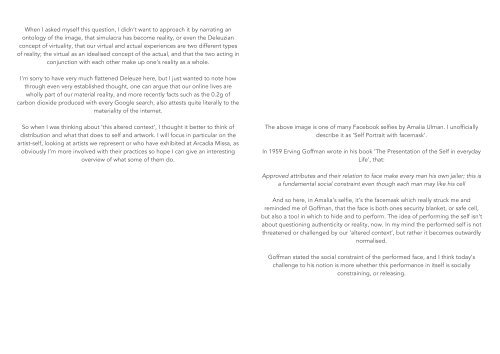The$Aesthe(cs$of$Exhibi(onism$ - Arcadia Missa
The$Aesthe(cs$of$Exhibi(onism$ - Arcadia Missa
The$Aesthe(cs$of$Exhibi(onism$ - Arcadia Missa
Create successful ePaper yourself
Turn your PDF publications into a flip-book with our unique Google optimized e-Paper software.
When I asked myself this question, I didn’t want to approach it by narrating an<br />
ontology of the image, that simulacra has become reality, or even the Deleuzian<br />
concept of virtuality, that our virtual and actual experiences are two different types<br />
of reality; the virtual as an idealised concept of the actual, and that the two acting in<br />
conjunction with each other make up one’s reality as a whole.<br />
I’m sorry to have very much flattened Deleuze here, but I just wanted to note how<br />
through even very established thought, one can argue that our online lives are<br />
wholly part of our material reality, and more recently facts such as the 0.2g of<br />
carbon dioxide produced with every Google search, also attests quite literally to the<br />
materiality of the internet.<br />
So when I was thinking about ‘this altered context’, I thought it better to think of<br />
distribution and what that does to self and artwork. I will focus in particular on the<br />
artist-self, looking at artists we represent or who have exhibited at <strong>Arcadia</strong> <strong>Missa</strong>, as<br />
obviously I’m more involved with their practices so hope I can give an interesting<br />
overview of what some of them do.<br />
The above image is one of many Facebook selfies by Amalia Ulman. I unofficially<br />
describe it as ‘Self Portrait with facemask’.<br />
In 1959 Erving Goffman wrote in his book ‘The Presentation of the Self in everyday<br />
Life’, that:<br />
Approved attributes and their relation to face make every man his own jailer; this is<br />
a fundamental social constraint even though each man may like his cell<br />
And so here, in Amalia’s selfie, it’s the facemask which really struck me and<br />
reminded me of Goffman, that the face is both ones security blanket, or safe cell,<br />
but also a tool in which to hide and to perform. The idea of performing the self isn’t<br />
about questioning authenticity or reality, now. In my mind the performed self is not<br />
threatened or challenged by our ‘altered context’, but rather it becomes outwardly<br />
normalised.<br />
Goffman stated the social constraint of the performed face, and I think today’s<br />
challenge to his notion is more whether this performance in itself is socially<br />
constraining, or releasing.


